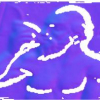Free Online Productivity Tools
i2Speak
i2Symbol
i2OCR
iTex2Img
iWeb2Print
iWeb2Shot
i2Type
iPdf2Split
iPdf2Merge
i2Bopomofo
i2Arabic
i2Style
i2Image
i2PDF
iLatex2Rtf
Sci2ools
CVPR
2008
IEEE
2008
IEEE
Dense 3D reconstruction from specularity consistency
In this work, we consider the dense reconstruction of specular objects. We propose the use of a specularity constraint, based on surface normal/depth consistency, to define a matching cost function that can drive standard stereo reconstruction methods. We discuss the types of ambiguity that can arise, and suggest an aggregation method based on anisotropic diffusion that is particularly suitable for this matching cost function. We also present a controlled illumination setup that includes a pair of cameras and one LCD monitor, which is used as a calibrated, variable-position light source. We use this setup to evaluate the proposed method on real data, and demonstrate its capacity to recover high-quality depth and orientation from specular objects.
Computer Vision | Controlled Illumination Setup | CVPR 2008 | Matching Cost Function | Specular Objects | Stereo Reconstruction Methods | Surface Normal/depth Consistency |
| Added | 12 Oct 2009 |
| Updated | 28 Oct 2009 |
| Type | Conference |
| Year | 2008 |
| Where | CVPR |
| Authors | Diego Nehab, Tim Weyrich, Szymon Rusinkiewicz |
Comments (0)

